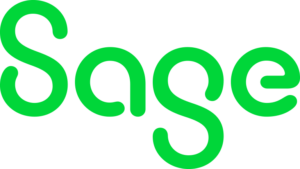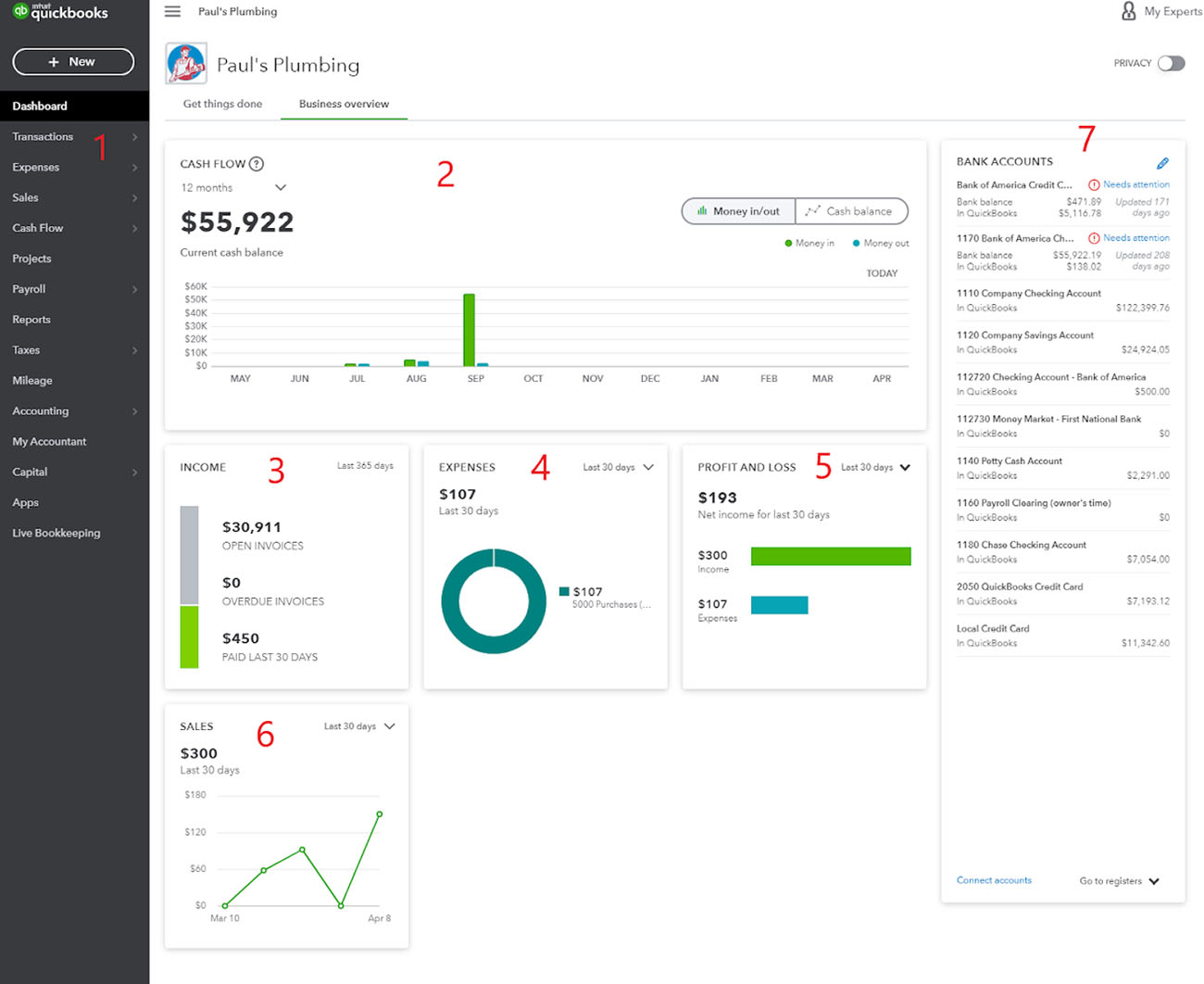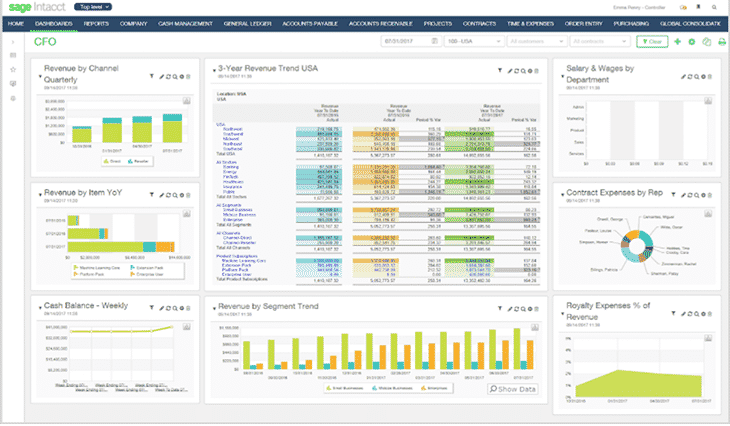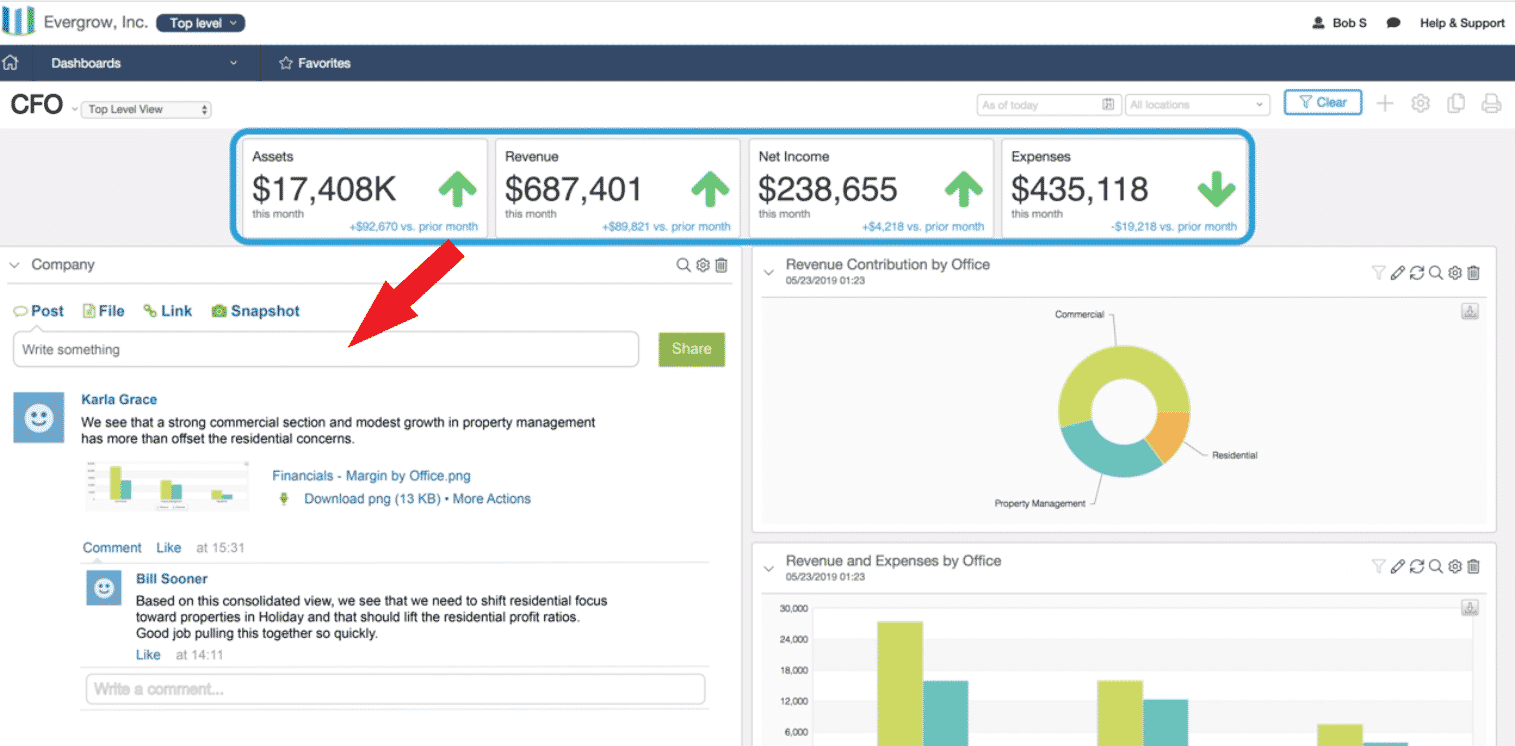Both Sage Intacct and QuickBooks Online are cloud-based accounting software that cater to a variety of industries. They have robust feature sets with hundreds of integrations to streamline your business processes. The choice between Sage Intacct vs QuickBooks Online depends on the complexity of your financial needs, the size of your business, your budget, and your comfort level with accounting software. It is important to thoroughly evaluate your specific needs to determine which solution aligns better with your business goals:
- Sage Intacct: Better for midsize or large businesses with multiple entities
- QuickBooks Online: Ideal for small businesses looking for an affordable, comprehensive bookkeeping solution
Sage Intacct vs QuickBooks: Quick Comparison
 | ||
|---|---|---|
Monthly Pricing | Custom quote | $35 to $235 |
Free Trial | ✕ | 30 days |
Discount | ✕ | 50% off for three months without the free trial |
Billable Clients | Unlimited | Unlimited |
Number of Users | Unlimited | 1 to 25 |
Overall Ease of Use | Requires a steep learning curve | Easy to use; doesn’t require any accounting experience |
Scalability | ✓ | ✓ |
Accessibility | Cloud-based | Cloud-based |
Mobile App | ✕ | Has most of the features of the desktop app |
Customer Service | Phone, live chat, email, and self-help guides | Phone (call back), live chat, and self-help guides |
Average Rating on Third-party Sites | ||
Use Cases & Pros & Cons
User Reviews: Tie
 | ||
|---|---|---|
Average Rating on Third-party Sites | ||
Users Like |
|
|
Users Dislike |
|
|
Both Sage Intacct and QuickBooks Online received mostly positive reviews, but I’m more impressed with QuickBooks because it maintains a high overall rating despite its broader user review base. For instance, on Capterra, QuickBooks is rated 4.3 out of 5 based on over 7,500 reviews, while Sage 50 has a 4.3 based on around 500 reviews. This isn’t necessarily a reflection of overall user experiences, but I would call this category a tie.
One satisfied user shared that Sage offers real-time budget visibility. They added that it is possible to extract data for reporting purposes. I also commend Sage Intacct’s useful integrations with other software like ADP Payroll, which streamlines processes.
On the downside, many users, including myself, find Sage Intacct difficult to use. One explained that it’s more ideal for someone with accounting knowledge than for businesses with no accounting experience. Someone also complained that Sage 50 doesn’t disclose its pricing; you must request a custom quote. There were also a few comments about product support being spotty, especially with API integrations.
As of this writing, here’s how Sage Intacct is rated on top review websites:
QuickBooks Online receives high praise for its ease of use and its excellent accounting feature set. While Sage Intacct also has robust accounting features, I found that QuickBooks is more comprehensive in many areas. For instance, in terms of banking, QuickBooks allows you to group multiple customer checks into a single deposit slip, making bank reconciliation much easier.
Other reviewers were critical of the fact that they were unable to manage multiple companies in a single account—which is possible in Sage Intacct. Another shared that the program doesn’t track inventory assembly, which can be an issue for manufacturing businesses.
QuickBooks Online earned the following average scores on popular review sites:
Pricing: Tie
 | ||
|---|---|---|
Plans & Monthly Pricing | Custom quote |
|
User Seats | Unlimited | 1 to 25 |
Billable Clients | Unlimited | Unlimited |
QuickBooks Online has transparent pricing, and both software offers unlimited user seats and billable clients.
They are so different in their approach to pricing. Unlike many other accounting platforms that are priced on a standard monthly or annual subscription basis, Sage Intacct’s pricing is quote-based. This means there’s no standard Sage Intacct cost, and instead, pricing is customized based on your business. For this reason, I ruled QuickBooks Online as the winner in this category.
Meanwhile, QuickBooks Online offers five subscription plans, which range in price from $35 to $235 per month and are based on the number of users and available features. To learn more about its different plans, check out our comparison of QuickBooks Online plans.
Features: Sage Intacct Wins
 | ||
|---|---|---|
Accessibility | Web browser | Web browser |
Track & Categorize Spending | ✓ | ✓ |
Double-entry Bookkeeping | ✓ | ✓ |
Track Unpaid Bills | ✓ | ✓ |
Track Time & Mileage | With Time Tracker integration | ✓ |
Track Income & Expenses by Class & Location | ✓ | ✓ |
Project Accounting Features | ✓ | ✓ |
Send Estimates | ✕ | ✓ |
Collaboration Tools | ✓ | ✕ |
View Customer History | ✓ | ✕ |
Multiple Entities | ✓ | ✕ |
Connect Bank Accounts | ✓ | ✓ |
Project Tracking | ✕ | ✓ |
A/P Automation | ✓ | ✕ |
Customized Workflow for Different Customer and Vendor Types | ✓ | ✕ |
Customization Options | ✕ | ✓ |
Generate W-2s for Employees | ✕ | With QuickBooks Payroll integration |
We selected QuickBooks Online as the best small business accounting software—and for good reasons, such as the ability to send estimates and track income and expenses by project. It excels with its strong customization features, which allow me to brand my forms and customize categories. If I have employees, I can generate W-2 forms if I’m integrated with QuickBooks Payroll (read our review of QuickBooks Payroll). However, QuickBooks cannot convert currency within reports, defer billing, and handle order management or processing.
It also has strong reporting and inventory tracking capabilities and more than 750 integrations. Additionally, it offers integrated payroll and time tracking (read our review of QuickBooks Time), which is great for businesses not wanting to use a third-party service. Both Sage Intacct and QuickBooks Online let me track income and expenses by class and location and through strong project accounting features like project and expense tracking and project invoicing.
Meanwhile, Sage Intacct has six overarching modules, and I can select the ones I need as part of my plan. These include core financials, dashboards, integrations, reporting, billing, budgeting and planning, and advanced functionality for an additional cost.
The platform makes it simple to create real-time dashboards across one or more entities without the need to export them to Excel. Dashboards can combine both financial and operational data, and with their built-in dimensions, I can analyze my data, drilling down to source transactions. It also allows me to set up customized workflows for different customers and vendor types and A/P automation in the form of a procure-to-pay workflow that starts with the purchase order and ends with the vendor invoice.
For all of Sage Intacct’s benefits, it cannot send estimates to customers, sales orders to vendors, and track time and mileage. However, it does have strong collaboration tools and the ability to view customer history and handle multiple entities, which are features that QuickBooks Online lacks. Because of these additional features, I chose Sage Intacct as the winner of this category.
Ease of Use: QuickBooks Online Wins
 | ||
|---|---|---|
Overall Ease of Use | Difficult | Easy |
Shortcut Buttons | ✓ | ✓ |
Online Help Section | ✓ | ✓ |
Intuitive Dashboard | ✓ | ✓ |
QuickBooks Online is very user-friendly, with a dashboard that allows access to many key features, such as my account balances, income and expense totals, and comprehensive charts. I also like that there is a navigation bar on the left that takes me to each section:

QuickBooks Online dashboard
- Left navigation bar: This section has shortcuts to different aspects of your business, including Transactions, Expenses, Sales, Cash Flow, Projects, Payroll, Reports, Taxes, Mileage, Accounting, My Accountant, Capital, Apps, and Live Bookkeeping. Payroll and Live Bookkeeping are add-on services for an additional fee.
- Cash Flow: Customizable by time period, this report lets me view my income, cost of goods sold, and expenses.
- Income: I’m able to view all income-related items, such as paid invoices, which are shown here. This information allows me to follow up on overdue invoices and view my A/R report.
- Expenses: My expenses, broken down by category, are shown here.
- Profit and Loss: My profit and loss (P&L) statement can be generated here.
- Sales: I can view a customizable sales graph generated during a specified time period.
- Bank Accounts: I’m able to connect my bank and credit card accounts to QuickBooks Online, and I can access both my bank and QuickBooks balances.
When I compared Intacct and QuickBooks Online for user interface (UI), Sage Intacct’s isn’t that user-friendly and can be overwhelming for beginners, which is why I chose QuickBooks as the winner in the ease of use category. Its advanced user interface is called Action UI, and it offers tools for A/P, bank reconciliations, and creating custom reports:

Sage Intacct’s CFO dashboard (Source: Sage Intacct)
Shown above is a chief financial officer (CFO) dashboard, which has reports that are unique to the business. This includes quarterly revenue by channel, three-year revenue trend, revenue by segment trend, weekly cash balances, and salary and wages by department. This allows the CFO to obtain a comprehensive glimpse at the different aspects of the business:

Documented correspondence (Source: Sage Intacct)
There’s also a front-to-back office compliance tool, which allows me to collaborate on decisions and document them in the context of the financial documents they relate to. In the future, I can replace recollections and speculation with a documented decision and audit trail.
Assisted Bookkeeping: QuickBooks Online Wins
 | ||
|---|---|---|
Monthly Cost | N/A | Starts at $300 |
Service Frequency | N/A | Monthly |
Monthly Reports | N/A | Monthly |
Day-to-Day Bookkeeping | N/A | ✕ |
QuickBooks Online offers assisted bookkeeping in the form of QuickBooks Live, which assigns me to a virtual bookkeeper. Its services include monthly reports that allow me to monitor the financial health of my business. My bookkeeper will first bring my books and reconciliations up-to-date and then work with me to tackle my ongoing work. However, this doesn’t include day-to-day bookkeeping tasks like paying bills, invoicing, A/P, and accounts receivable (A/R)—but it does allow for both cash and accrual accounting.
If my issue is a bit more complex, I might want to consider consulting with someone from Intuit’s expansive network of independent QuickBooks ProAdvisors. Our guide on how to find a QuickBooks ProAdvisor is a great resource.
Meanwhile, Sage Intacct doesn’t have a dedicated bookkeeping service, but I recommend taking advantage of its partnership with the American Institute of Certified Public Accountants (AICPA) and CPA.com to select from the best outsourced financial pros for your business.
Integrations: Tie
Sage Intacct offers the ability to connect to all applications, whether they’re proprietary custom applications or widely used business systems like Salesforce CRM. I’m able to do this by accessing prebuilt connections that are available through the Sage Intacct Marketplace.
QuickBooks Online, on the other hand, currently integrates with more than 750 popular business apps, including others that can be accessed directly within the platform. Check out our guide to the best QuickBooks Online integrations for small business owners.
Mobile App: QuickBooks Online Wins
 | ||
|---|---|---|
Accessibility | N/A | iOS and Android |
Create & Send Invoices | ✕ | ✓ |
Capture Expense Receipt | ✕ | ✓ |
Accept Payments Online | ✕ | ✓ |
Categorize Expenses From Bank Feeds | ✕ | ✓ |
View Reports | ✕ | ✓ |
Enter Bills & Bill Payments | ✕ | ✕ |
Record Time Worked | ✕ | ✕ |
Assign Time Worked to a Customer or Project | ✕ | ✕ |
Track Business Mileage | ✕ | ✓ |
Available for both Android and iOS devices, the QuickBooks mobile app gives an overview of my business activity and allows me to accomplish multiple accounting tasks wherever I am. I can view dashboard data, create and send invoices, accept payments, capture receipts and attach them to expenses, reconcile transactions, view customer information, and message customers from the app. I can also track your mileage using GPS, which you can categorize as business or personal.
Other than accessing Sage Intacct through the web browser, it doesn’t have a mobile app, so I selected QuickBooks Online as the winner of this category. However, Sage Intacct does have a mobile-friendly browser interface, so you can still access it when you’re on the go.
Customer Support: QuickBooks Online Wins
 | ||
|---|---|---|
Live Chat Support | ✓ | ✓ |
Chatbot | ✓ | ✓ |
Self-help Resources | ✓ | ✓ |
Phone Support | ✓ | Callback only |
Email Support | ✓ | ✓ |
24/7 Support | Premium support plans only | Advanced plan only |
Both Sage Intacct and QuickBooks Online offer a variety of ways to receive support. QuickBooks offers the following:
- Telephone support: While phone support is available, it isn’t possible to call QuickBooks Online directly. I must submit a request for them to call me back.
- Email support: Email is an option if my issue is less time-sensitive.
- Live chat support: If I can’t find what I’m looking for, I can contact the support team by clicking on the “Contact us” button at the bottom of the help window. However, this is unavailable 24/7.
- Searchable knowledge base: This includes help pages, videos, webinars, and paid courses.
- User community: Post a question in the community forum and receive feedback from other users who may be able to help troubleshoot the issue.
Sage Intacct, meanwhile, has a Help Center that covers how to use its features and functions. I can also visit Sage Intacct Community, which is available 24/7 and allows me to submit a support case, monitor the status of my open cases, and access the knowledge base for articles on common issues and troubleshooting solutions.
It also offers premium support plans at four levels: Essentials, Bronze, Silver, and Gold. These give me unlimited access to phone support and enable me to obtain answers related to product features quickly.
Frequently Asked Questions (FAQs)
Sage Intacct is more robust and scalable than QuickBooks Online, making it suitable for larger organizations with complex financial needs. It offers advanced features like multientity support and sophisticated reporting.
Yes, QuickBooks Online provides mobile apps for both iOS and Android devices, allowing you to manage your finances on the go.
Yes, Sage Intacct offers multicurrency support, which is ideal for businesses that operate internationally.
QuickBooks Online offers basic inventory management features, including the ability to track inventory levels, create purchase orders (POs), and manage stock items. It also calculates your cost of goods sold (COGS) automatically.
Bottom Line
Sage Intacct bills itself as the number one choice for organizations outgrowing QuickBooks. It helps CFOs and businesses with multiple entities access integrated management and financial reports across their business entities and delivers automation and controls around billing, accounting, and reporting to reduce errors, stay audit-ready, and scale the business. While QuickBooks Online offers many of the same features, it lacks Sage Intacct’s advanced capabilities, such as fund accounting and collaboration tools.
User review references:
[1]Capterra | Sage Intacct
[2]G2.com | Sage Intacct
[3]Capterra | QuickBooks Online
[4]G2.com | QuickBooks Online




